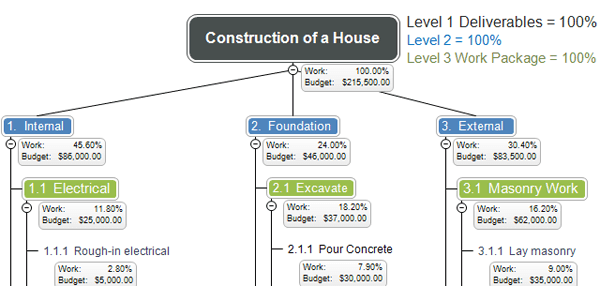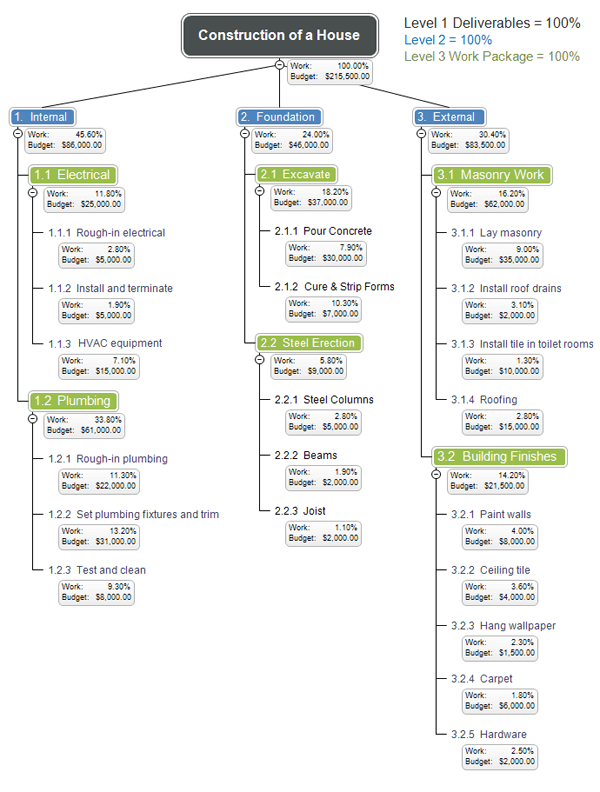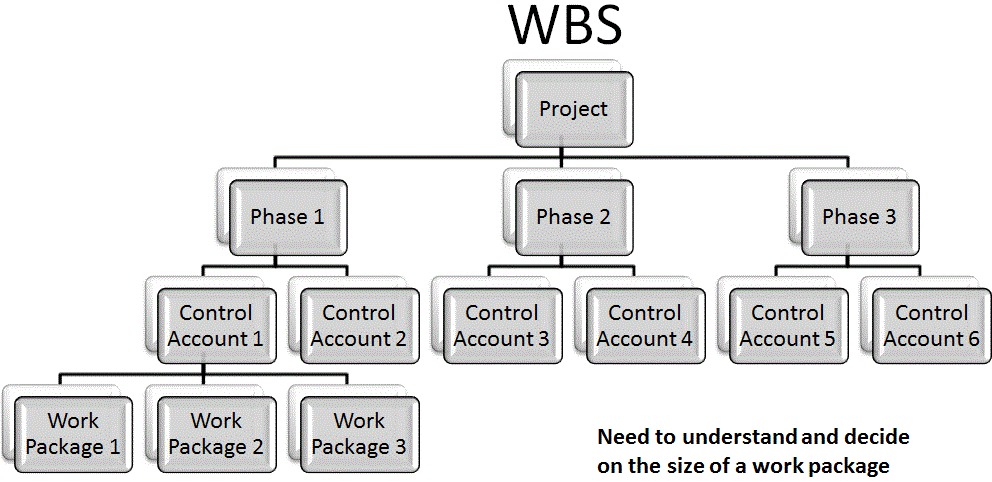Work Breakdown Structure (WBS)
A work breakdown structure is a "deliverable oriented hierarchical decomposition of the work to be executed by the project team." The work breakdown structure visually defines the scope into manageable chunks that a project team can understand, as each level of the work breakdown structure provides further definition and detail.

Why use a Work Breakdown Structure?

As a project leader, you should create the WBS in iterative cycles and constantly reevaluate the hierarchy of deliverables & activities. You should also validate that you have broken down every deliverable into all the high-level activities required to complete it.
At the end of every cycle, ask yourself and your team members these three questions:






A work breakdown structure is a "deliverable oriented hierarchical decomposition of the work to be executed by the project team." The work breakdown structure visually defines the scope into manageable chunks that a project team can understand, as each level of the work breakdown structure provides further definition and detail.

Why use a Work Breakdown Structure?
- Allocating time and cost estimates to specific sections of the WBS, helps in visualization of project schedule and budget.
- If a WBS branch is not well defined then it represents a scope definition risk.
- Integrating WBS with an organizational breakdown structure, helps formulate a communication plan.
- When a project is falling behind, referring the work breakdown structure will quickly identify the major deliverable impacted by a failing work package or late sub-deliverable.

As a project leader, you should create the WBS in iterative cycles and constantly reevaluate the hierarchy of deliverables & activities. You should also validate that you have broken down every deliverable into all the high-level activities required to complete it.
At the end of every cycle, ask yourself and your team members these three questions:
- If I had all these deliverables, would I achieve the planned objectives for the project?
- If I do all these activities, will I complete that deliverable?
- If I do all these subactivities, will I complete that activity?
- The top level represents the final deliverable or project
- The work package defines the work, duration, and costs for the tasks required to produce the sub-deliverable
- Work packages ideally should not exceed 10 days of duration
- Work packages should be independent of other work packages in the work breakdown structure
- Work packages are unique and should not be duplicated across the work breakdown structure
- Avoid too much of decomposition. Balance is required else increases complexity, causes this process to take longer than is actually needed, and makes the project unnecessarily complex both to plan and manage.
- Determine whether you want to build a WBS that is process oriented or product oriented. What’s the difference? If the results you want from your project can be defined in verbs, then you want a WBS that is process oriented. If you want a WBS that is built on nouns, then it will be product oriented. It is easier to build a process oriented WBS as this is like organizing a To-Do list.
Control account = A management control point where scope, budget (resource plans), actual cost, and schedule are integrated and compared to earned value for performance measurement. It is a tool.
A Control Account can contain either a single or multiple deliverable s and should span enough
time so that its progress can be measured and a trend established that can be used to affect the
outcome of that Control Account. On medium to large projects, it is recommended that a
Control Account should be between 8 and 24 months in length, although this is just a guideline.
Larger groupings of items into fewer Control Accounts make it easier to manage the Control
Accounts. Control Accounts should be developed by staff knowledgeable about the work to be
performed and set at a level that is appropriate for the specific project.
Earned value is applied at the Control Account level. When a Control Account is originally
established, the Project Manager will cost load the Control Account and establish the earning
rules for it
Planning Package = A work breakdown structure component below the control account with known work content but without detailed schedule activities.






Different Types and Uses
A Project WBS, depending on the purpose, has four types:
- Products/Services Oriented
- Results Oriented
- Work/Task/Activity Oriented
- Mixed Products/Services, Results and Work/Task/Activity Oriented
No comments:
Post a Comment